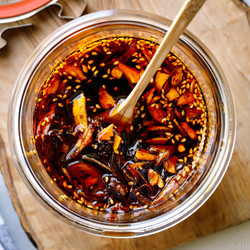Gather all the ingredients. Use the outer large cloves of a colossal or very large garlic bulb.
Thinly slice 1 shallot lengthwise.
Peel 6 cloves garlic without crushing them. Then, cut the cloves lengthwise into thin, uniform slices.
Set a wok (I use this 10" carbon steel wok; use “JOC10“ for a 10% discount) or stainless steel saucepan on medium-low heat and add ⅓ cup neutral oil and the shallot slices. Bring the oil up to temperature while you spread the shallot slices around the pan in a single layer using a fine-mesh skimmer spoon or a slotted spoon. Because shallots contain a lot of moisture (which causes the oil to bubble from evaporation), it can take awhile to fry and crisp up.
Once the bubbling subsides, the shallot slices will slightly sizzle while cooking. Once they look lightly golden brown, remove them with the fine-mesh skimmer and drain the oil. Then, transfer them to a paper towel-lined plate or tray to absorb any excess oil. Set aside. Tip: Take out the shallots sooner than you think. Don‘t wait until they are perfectly golden brown. The remaining oil will continue to brown the shallots.
In the same oil in the wok over medium-low heat, add the garlic slices. Bring up to temperature and cook the garlic slices until they are lightly golden brown, flipping halfway. Tip: Make sure your stove‘s heat is not too strong, as the garlic will burn if the heat is too high.
When the garlic slices are lightly golden, transfer to the paper towel-lined plate in a single layer and place another sheet of paper towel on top to absorb any excess oil. Let cool completely. Tip: Reserve the shallot- and garlic-infused oil for cooking other food.
Once the fried shallots are cool, cut them into smaller pieces with a pair of kitchen scissors.
Put the fried garlic chips in a bag and crush them with your hands or between your fingers.
First, make the gochugaru mixture: In a heatproof bowl, combine 3 Tbsp gochugaru (Korean pepper flakes) and 1 Tbsp toasted white sesame seeds and set aside. (Add the optional 1 oz dried shrimp and/or 1 oz nuts now, if using.)Next, make the oil mixture: To a wok or stainless steel saucepan, add ½ cup neutral oil and ½ cup toasted sesame oil. I don‘t recommend using a frying pan, as it‘s harder to pour hot oil into a bowl. (Add the optional ichimi togarashi (Japanese chili pepper), 1–2 slices ginger, and/or green part of 1 green onion now, if using.)
Heat the oil mixture to 340–350°F (170–180°C) and remove from the heat. (Discard the ginger and green onion, if using.) Tip: If you don‘t have a kitchen thermometer, scoop hot oil using a spoon and pour it onto the gochugaru mixture. If it sizzles, the oil is at the right temperature.
Pour the hot oil mixture over the gochugaru mixture (it will sizzle). Stir well to distribute the hot oil throughout the mixture.
Add ½ tsp Diamond Crystal kosher salt, 1 tsp sugar, and 1½ Tbsp gochujang (Korean chili paste) to the oil mixture. Mix well and let cool, for about 30 minutes or until the bowl is cool enough to touch. (Add the optional soy sauce now and remove the ginger and green onion, if using.)
Add the fried shallots and garlic chips to a clean, sterilized jar. Tip: To sterilize the jar (and the lid and ring), place them in boiling water for 10 minutes and make sure they are completely submerged.
Next, add the chili oil mixture to the jar. Tip: Transfer the gochujang mass first, so it won‘t splash in the oil at the end.
Stir to combine well with the fried shallots and garlic chips. Your Taberu Rayu is now ready to use.
Enjoy Taberu Rayu the classic way on steamed rice, or try it in Onigiri and on Japanese Rice Porridge (Okayu). Drizzle it onto Gyoza, sliced avocado, fresh cucumbers, fried eggs, and Japanese Fried Chicken (Karaage). Taberu Rayu is also delicious as a topping for Cold Tofu (Hiyayakko) and Hot Tofu (Yudofu) or mixed into natto (納豆). Try it in your favorite hot bowl of ramen, udon, and soba noodle soup or on cold noodles. Mix it into boiled pasta, Fried Rice, and stir-fries for texture and a savory flavor. It‘s also delicious on salad, especially chilled Shabu Shabu Salad!
Store the Taberu Rayu in a clean glass jar for up to 1 month in the refrigerator. Chili oil can go bad and should be discarded if it has a rancid smell or a very unpleasant flavor.
